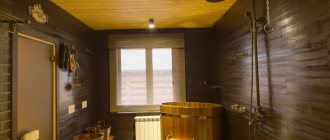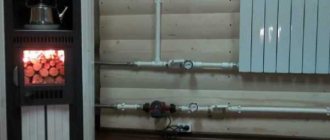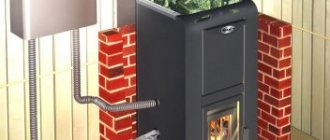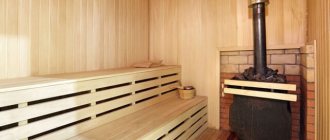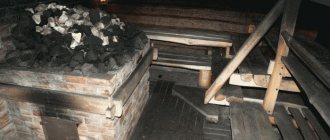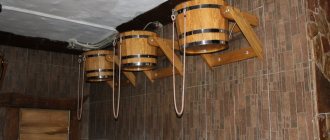A stove with a tank is the best option for a bathhouse.
Manufacturers offer a variety of models that differ in power, water tank volume and other parameters.
When choosing a suitable device, you should familiarize yourself with the design features and the principle of its operation.
And also consider different types and models.
On smartphones, you can scroll the table right/left ↔
| Place | Name | Price |
| TOP 7 best sauna stoves with a water tank | ||
| 1 | Harvia M3 SL | Find out the price |
| 2 | Harvia 20SL | Find out the price |
| 3 | Harvia Club Combi K15GS | Find out the price |
| 4 | Konvetika 12B | Find out the price |
| 5 | TMF Biryusa 2013 | Find out the price |
| 1 | Harvia Virta Combi HL90S | Find out the price |
| 2 | Harvia 20 ES Pro | Find out the price |
Design features
A sauna stove with a water tank provides heat to the building. Bricks or ferrous metal are used to make it. It maintains the required temperature, including the heat in the steam room. This design includes the following main parts:
- The firebox is designed for burning fuel. This is where heat is released.
- A heater used to conserve thermal energy by heating stones due to the combustion of wood in a firebox.
- Grate, which is made of cast iron. Its installation can be done in different positions. The placement of the grill depends on the type of fuel used. When a sauna stove with a water tank and a heater is designed to burn wood, then the grate is installed at the same level as the door.
- Ash pan located under the fuel compartment. It is used to accumulate ash. Its removal is done manually.
- A tunnel with a door designed for heating the stove from the dressing room.
- A heat exchanger used to transfer thermal energy to water.
- A smoke exhaust duct, which is a pipe. She comes out of the firebox.
Design of a stove with a tank Source oboiman.ru
Wood-burning or electric stove for a bath: what to take?
Well, if we are not talking about a stove that will be in an apartment or house, then the choice is really relevant. A wood-burning or electric sauna stove has its advantages, as well as disadvantages, and by weighing them, you can come to a thoughtful decision.
Electric heaters are easier to maintain , wood-burning ones will require the skills of a stoker, and also guarantee constant concern about the condition of the ash pan, chimney, replenishment of firewood and other chores.
But electricity is much more expensive than firewood , and installing a sauna stove requires inviting a professional electrician , who can tell you that your wiring is unsuitable and needs to be replaced. (Of course, this does not always happen.)
By the way, to find out which of the stoves - 220 volts or 380 - is suitable in your case, we recommend reading this article.
Arrangement of a sauna also requires the creation of a grounding loop , and some of the work must be carried out at the construction stage - laying a mesh on the waterproofing, edging the perimeter with a steel strip to which the mesh is welded, and then connecting the structure to the zero on the panel.
A wood stove will require, at a minimum, the construction of a foundation , and at a maximum, a separate foundation. In addition, the correct installation of a chimney is also not an easy task . In the case of a remote firebox, you will also have to build a fire-resistant wall .
Thus, in no case will it be completely without difficulties , but we agree to some things easier, so the decision about which stove will be in your steam room is yours. We only advise you to read our article, which provides more food for thought about different types of sauna stoves.
And for those who are strongly inclined to purchase an electric stove for a bath , we advise you to read the article about the intricacies of its choice and this short review of electric stoves.
Operating principle
Almost any sauna stove with a water tank works on the same principle. First, the firewood is placed in the firebox. Then the fuel is lit. After this, the hot air begins to rise and pass through the heater. As a result, the stones heat up. They become very hot and gradually give off heat. Therefore, the steam room maintains a high temperature for a long time.
Depending on the models, it is often necessary to periodically add firewood to the stoves during operation. After all, this type of fuel is characterized by rapid combustion. Its addition to the firebox allows you to maintain a comfortable temperature in the room for a longer time.
It is recommended to use birch firewood or alder logs as fuel. A stove in a bathhouse with a tank can also be heated using coal or peat briquettes. In any case, dry fuel must be used. In this state, it will allow you to quickly heat the bath rooms. It is not recommended to use coniferous firewood because it produces a large amount of soot. As a result, the smoke exhaust duct will become more quickly contaminated.
Birch firewood for a sauna stove Source stiproduction-a.akamaihd.net
Manufacturers produce long-burning models. These stoves do not require adding wood for 6-20 hours. This makes it easier to control the room temperature. Such furnace devices differ in the combustion process. It happens from top to bottom.
Advantages and disadvantages
The advantages of electric furnaces for heating saunas and baths include:
- Quick heating of the room and stable maintenance of the temperature in it.
- You can choose a model that is compact in size.
- Unlike gas furnaces, there is no need to coordinate the installation of the device.
- Quick and easy installation of equipment.
- There is no need to organize firewood storage.
- Such a stove operates without a chimney.
- Easy to manage, maintain and operate.
- Availability of built-in fuse against overheating.
- Reliable thermal insulation guarantees the safety of using the electric furnace.
- There is no carbon monoxide emission during operation.
Among the disadvantages are:
- The high cost of electrical energy does not allow using the bathhouse for procedures too often and for a long time.
- It is not always possible to install a powerful stove due to power limitations in the electrical network in a private residential building in the range from 4 to 6 kW.
- Compared to devices running on wood or natural gas, the heating power of electric furnaces may be lower.
Types of sauna stoves by material
A modern bathhouse stove with a water tank can have a brick or all-metal structure. In the manufacture of the first version of the device, steel and cast iron are usually used. Manufacturers produce metal stoves in different designs. There are a huge number of such models on the market.
Metal stoves can have a square, cylindrical, rectangular shape. Any such device is quite easy to install. There is no need to build a foundation during its installation. A metal stove can heat a room in a short period of time. At the same time, this design cools quickly and has poor resistance to sudden temperature changes.
Metal sauna stove Source prom.st
Brick sauna stoves have a longer service life. They are able to retain thermal energy longer and have an attractive appearance. However, for their construction it is first necessary to build a foundation. Therefore, creating brick devices requires more time and physical effort than installing metal furnace structures.
See also: Catalog of companies that specialize in the design and installation of fireplaces and stoves
Types of stoves according to the location of water containers
Bathhouse owners have the opportunity to choose a stove with a different location of the water tank. A professional in this field will always help you choose the best option. Therefore, if you need to equip a building with such a device, it is better to immediately contact a specialized company.
Remote water tanks
This variety is one of the best designs. After all, such a tank for water in a bathhouse is usually located outside the steam room. In this case, the oven is located in the steam room. Therefore, it heats not only the steam room and water, but also the neighboring room. At the same time, the humidity in the steam room does not increase as long as there is cold water in the container.
Remote tank in the next room with a steam room Source fgssm.ru
Typically, stainless steel is used to make this type of tank. More often, a remote tank for hot water in a bathhouse is installed in an adjacent room with a steam room. To heat water from the furnace structure, a register is additionally installed. In this case, the connection of all elements of the system is carried out by laying pipelines.
The register and the tank are connected using pipes that can withstand high temperatures. It is recommended to lay copper or stainless steel pipelines at least 500 mm from the furnace structure. If they are connected to metal-plastic pipes, then special fittings are used.
A remote water tank in the bathhouse is installed subject to certain rules:
- the lower level of the tank must be at least 500 mm above the register;
- the length of pipelines should be a maximum of 3000 mm;
- pipes must be installed without sagging;
- the diameter of the pipelines must be at least 25 mm;
- Pipe installation should be carried out with a slope of 2° to 5°.
Design of a system with a remote tank, heat exchanger and stove-stove Source oboiman.ru
Water is poured into a cold system. If you do the opposite, then there is a high probability that the register will break due to a sudden change in temperature.
Equipping the bathhouse with a remote water tank allows you to equip the building with a separate shower. You can also organize a Finnish sauna in the building or connect a radiator to heat, for example, a locker room during the cold season.
Installation of such a system is accompanied by certain difficulties. However, its arrangement is not cheap. After all, you need to purchase pipelines, a register, a container, a tap for a hot water tank in the bathhouse and the stove itself. In addition, you will need to pay for the work of professionals who will install the entire system.
Built-in water tanks
This type of tank is usually mounted above the firebox. Such a tank for hot water in a bath can also be placed on either side of the stove. However, the containers differ in shape. However, the most popular is the rectangular tank.
Metal sauna stove with built-in water tank Source prostopechi.ru
Built-in containers are often made of stainless steel. Typically the metal thickness is from 0.8 to 1.5 mm. The design has a hole for filling water, and to drain it, a ball valve is installed in the lower part.
The built-in container is inconvenient to use due to the fact that it cannot be left empty when the stove is in use. At the same time, a constantly filled tank causes a regular increase in humidity in bath rooms. Therefore, they do not always have time to dry. In addition, you constantly have to monitor the water level and periodically replenish the volume of the bath tank.
Video description
One of the furnace options with a hanging tank is described in the video:
Attached water tanks
This type of tank is an original option. However, it is not often used in baths. The design contains a pipe, which is placed at an angle from the bottom of the container to the furnace. In this case, the tank is mounted above the furnace device.
During heating, the water first pours and boils in a pipe that is inclined. As a result, bubbles form. They travel down an inclined pipe into cold water and burst. Thanks to this circulation, heat transfer occurs.
Water tanks for chimneys
Tanks installed on smoke exhaust ducts are a popular type of tank for heating water. Its temperature rises due to hot air passing through the pipe. The smoke channel is located in the center of the tank.
The tank for heating water in the bathhouse on the chimney can have different designs. Manufacturers make such containers in triangular, oval, square, round and other shapes. This allows you to select a tank for a specific stove, chimney configuration and building.
Sauna stove with a tank on a pipe Source kraski-net.ru
By using a tank on the chimney, heat does not escape into the chimney. In addition, the temperature of the smoke exhaust duct decreases. Therefore, its service life increases. This type of tank also allows you to save usable space in the steam room and throughout the bathhouse.
One of the disadvantages of tanks on chimneys is the inconvenience of filling them with water. After all, the hole for it will be located higher than most other similar containers. The exception is tanks that are mounted immediately above the stove. In a pipe-based design, it is still difficult to control the water level and its temperature.
In addition, a sauna heater stove with a water tank on the chimney is equipped with additional fasteners. They are needed to securely place the container. After all, its weight with water can be, for example, 100 kg. This drawback complicates the installation of the tank on the smoke exhaust duct.
Construction of metal furnaces
Metal is a more malleable material than ceramics; it can be melted and cast, drilled, cut, bent, and forged. There is a considerable amount of metal processing. Basically, when making a stove with your own hands from metal, you need to focus on its quality. The metals used for the production of the heating mechanism are: ordinary steel, heat-resistant variations of steel, surrogates and cast iron.
The second step will be to create a stove and choose the type of its design. The dressing comes in different forms, the main thing is to follow the joining technology. For this, there are diagrams where the structural properties of all elements are depicted in detail. It can be created with an open or covered heater. Carefully take into account the dimensions of the bath itself. The elementary design should consist of a water tank and a firebox, and definitely have a tube, a rod and a grate.
It should also have strong latches. To remove the results of combustion, it is advisable that the stove be equipped with a chimney pipe. And also a tap that will be mounted on a water tank. Not all stoves look harmonious in the interior of the house; this problem can be solved by removing the portal for the sauna stove with your own hands.
Differences between metal stoves for baths and saunas
Steam rooms in a sauna and a bathhouse have impressive differences, these are the temperature and dryness of the air. In the bathhouse, the temperature varies from 50 to 70 degrees, resulting in the formation of soft steam. The temperature in the sauna is above 85 degrees Celsius, the steam comes out dry. To create certain conditions in the steam room, different stoves and various approaches to their installation are used.
To build a sauna, it is necessary to maintain maximum contact between the stove shell and air in order to ensure rapid circulation of air flows along the walls.
It all comes down to heating the air faster. In the bathhouse, the microclimate is organized in a different way, where a high temperature is reached and a lot of steam is generated. To achieve the effects, stones are placed in a firebox, that is, in a closed heater. A small heater is placed above the firebox, which helps heat the stones to 250 degrees Celsius.
The next difference is that metal sauna stoves are convection, and all baths are organized in such a way as to avoid thermal convection without any trace. Convection in the usual syllable is the movement of air inside a room.
Do-it-yourself stoves for Russian baths
The current Russian bathhouse is a small house made of timber or logs. Inside, as a rule, there is a division into 2 rooms, namely a dressing room and a steam room. A stove for a Russian bath is not just a heating mechanism, it is its most important accessory. The temperature, dryness and heating level of the steam room depend on it. There are many categories of sauna stoves.
But not everyone is suitable for a Russian bath. The fundamental difference will be warming the air to a temperature of 65 degrees Celsius, while creating steam between 60 and 80 percent. As a result, so-called weak steam is formed in the steam room.
This is a pleasant, moderately or almost non-burning velvety steam. In a true Russian bath you can breathe nicely and simply, and your skin will not experience severe thermal stress.
Often a brick or steel stove is installed in a bathhouse. All these materials heat up well and transfer heat well to the room. There are no stamps for the construction of stoves; only the general principles of architecture and construction are observed.
Brief description and dimensions of the metal stove
An iron sauna stove can effectively heat small rooms. It is created by a covered, open and combined design. The mechanism has a tank for heating water and a heater built into the upper part of the stove. The closed device consists of 3 compartments, this is a chamber with a blower, a heater and a hole for steam outlet, and a tank for heating water.
An open-type installation has a metal grate on which stones are placed, which is located above the combustion chamber. There are no barriers between the firebox and the stones. Combined devices of this group are distinguished from others by the presence of an enlarged combustion chamber, equipped with double bolts and grates.
Fire from all edges heats the heater, and this significantly increases the productivity of the stove. The volume of the oven varies; during its construction, the parameters of the steam room and the number of people washing in it are taken into account.
The size of the heating system depends on the strength of the heating system. The higher the coefficient, the more fuel needs to be burned. For ideal air heating, the parameters of a sauna stove must be as follows: the ratio of the size of the firebox to the area of the heated room is 1:50 or 1:70, the depth of the firebox opening is 1:2 or 2:3, and the volume of the firebox to the cross-section of the chimney should be in proportion 1: 10.
A heat exchanger for a sauna stove is a technical unit that heats the incoming liquid and then transfers it to a hanging container.
Design features of a metal furnace firebox
The furnace firebox is the most important element of any hearth. It sets the characteristics of the furnace, since the heating speed and the quality of the steam produced depend on it. A firebox or firebox is a device for burning organic fuel. Fireboxes are made from different materials, are designed for different types of fuel, and have different sizes.
A metal or ready-made furnace firebox is a high-tech device that is more economical in fuel consumption. Its efficiency depends on proper design.
The classic firebox for sauna stoves consists of the following basic elements:
- front is the front part of the combustion space where the loading door is located;
- the head wall, where, depending on the furnace mechanism, an outlet window for removing flue gases may be located;
- the arch of the firebox or ceiling where the exit window is located;
- sole - the lower horizontal part of a closed combustion volume.
It can be internal, located directly inside the furnace, or external, this is a tunnel passage; fuel can be loaded from another room.
What are metal sauna stoves made of?
An iron sauna stove is a classic version of long-burning with a water outline. The device consists of a sealed metal box equipped with a combustion door and an exhaust pipe.
To produce metal sauna stoves with your own hands, you will need raw materials and parts:
- a steel sheet with a thickness of approximately 8 millimeters;
- doors for the firebox, blower and heater;
- tap water;
- grate;
- chimney pipe.
When carrying out the equipment, it is necessary to use thick metal, so the device will predominantly generate heat when heated.
Video description
The video describes about containers for chimneys from sauna stoves:
One of the types of containers for chimneys are tanks that are connected to an external storage structure. Typically, such models have a small volume. They are equipped with two pipes for connection to a remote tank. The structures are connected to each other by pipelines to move cold and heated water.
A small tank on the pipe is the so-called water jacket. This design has a number of advantages:
- Convenient installation due to low weight and volume.
- Possibility of installing a remote container anywhere in the bathhouse.
- Increased comfort when pouring water into a separate large tank and monitoring the liquid in it.
- The absence of excess humidity in the steam room due to the placement of the main container outside the steam room.
- Possibility of connecting a separate tank to the shower system.
Electric sauna stove 220 volts with heater: is it worth buying, price
When choosing sauna stoves, it is recommended to first study the power indicators. When buying a 220 V design, you need to understand that its power is enough for a bathhouse with a limited area and a small volume of heated air. In this case, only a classic single-phase power supply is suitable for operation. Three-phase models can be purchased starting from 20 thousand rubles.
For those who want to provide heat and steam for a large family bath, a 380V electric heater would be preferable. When comparing capacities, a 220V oven loses to its three-phase counterpart.
The capabilities of the existing electrical wiring system are also taken into account. Before connecting electric furnaces, it is recommended to consult with an electrician, who will give an assessment and determine whether the wiring will withstand the power supply of a bathhouse with a furnace of the selected power or not.
Requirements for stoves with water tanks
The best option for a stove with a water tank is a design that has:
- compact sizes;
- reliable device and operation;
- simple operation;
- high efficiency.
To operate efficiently, the stove must have a steam and heat generator. They will allow you to regulate the power of the structure. Moreover, this characteristic is selected in accordance with the size of not only the steam room, but also all heated rooms in the bathhouse.
Experts recommend giving preference to devices that have a convention system. Thanks to its presence, it will be possible to regulate the temperature and speed up the heating process of the building. In addition, the stove must have a durable coating, regardless of its type.
Bath water tank material
When choosing a container, the material from which it is made is important. It affects the heating and cooling time of water. The service life of the structure also depends on it.
Metal tanks for the bathhouse Source bestmet.ru
Previously, hot water tanks were made exclusively from cast iron. In such structures, the water takes a long time to cool. At the same time, cast iron is highly resistant to corrosion and temperature changes. Therefore, cast iron tanks are durable containers.
Despite the positive aspects, cast iron tanks are made by a small number of manufacturers. In such structures, water takes a long time to heat up, and they are heavy. Some models are even mounted on a specially constructed foundation.
Manufacturers also produce steel tanks coated with enamel. It protects containers from corrosion. However, the enamel coating can be damaged by mechanical stress. In this case, the tank will begin to rust. In this case, the tanks are coated with enamels of different colors.
A tank for cold water in a bath or for constantly being in a hot state can be made of stainless steel. Containers made of this metal are popular options. They are corrosion-resistant and quickly allow you to heat water. Stainless steel tanks can withstand sudden temperature changes. However, in such structures the water cools quickly.
Stainless steel bath tanks Source 24aul.ru
How to choose and what to pay attention to?
First of all, it is worth paying increased attention to the quality of thermal insulation . The role of insulation is usually performed by a layer of air between the steel sheets that make up the body of the electric furnace. Some models are faced with tiles or natural stone.
This design makes it possible to increase the safety of using the unit, protecting against burns when touching the body.
Another important aspect when choosing an electric heater is the device control mechanism . It can be equipped with a built-in control panel, a mobile remote control, or a combination of both elements.
Another criterion is the level of required voltage in the electrical network . There are units with requirements of 220 or 380 V. The second option is more economical, but it is less often found on sale.
The built-in container allows you to always have a supply of hot water on hand for washing while the electric stove is running, and also more effectively humidify the air in the steam room.
Material of manufacture
The following types of materials are used for the production of electric heaters::
- cast iron - durable and retains heat well, but is heavy;
- enameled steel is an inexpensive but not very common option;
- Stainless steel is the most popular material, characterized by durability, aesthetics and good heat dissipation.
Heater type
Heaters vary in volume. It is the stones that produce heat and allow steam to form.
For a compact sauna, 2-2.5 kilograms of stones may be sufficient . In a large room, you need to install a stove that can fit at least 6 kilograms of stone into the heater.
Furnace design
According to the type of design, electric sauna stoves are divided into open and closed . To generate a significant amount of dry steam, open-type heaters are used.
If you only need a little steam, it is better to choose a stove with a closed heater, which will retain heat longer.
Installation method
Based on the installation method, electric furnaces are divided into wall-mounted and floor-mounted structures. Mounted electric heaters have a low power level and are usually used in saunas and bathhouses of modest size.
The range of floor-standing devices is distinguished by a large selection. You can find both compact low-power ovens and powerful, large devices powered by a voltage of 380 V.
Heated volume
The power level of the electric furnace is selected according to the following indicators:
- 1 kW of power * 1 m3 of steam room.
This calculation is valid for steam rooms that have high-quality insulation of wall surfaces, ceilings and floors.
A popular option for installing a water tank in a bathhouse
Heating water in a bathhouse can be done not only using heat from the stove. Manufacturers still produce models of tanks in which heating elements are installed. The specific device is selected depending on the frequency of visiting the bathhouse and the number of people.
For convenient use, it is better to connect the structure to a water supply. This will eliminate the need to use a hose to draw water into the reservoir.
Experts in this field know well how to install a hot water tank in a bathhouse. They will take into account all the features of the building. If the stove is equipped with a coil on a pipe, then a separate tank must be additionally installed. It is usually installed on the wall. It houses the main supply of water, which will be heated in the coil. Therefore, the structures are connected using pipelines.
The connection process itself is carried out by connecting a pipe to the upper branch pipe of the coil, through which heated water will move to the storage tank. The lower outlet of the heat exchanger is connected to a pipeline used to supply heated liquid to the coil.
Conventional diagram of the connection of a heat exchanger on a pipe with a storage tank Source strport.ru
Additionally, a check valve and safety valve are installed. They are installed on a pipe through which cold water enters the tank. Valves are installed at the entrance to the cold water pipeline tank. At the same time, they are adjusted to a certain pressure at which they operate. Thanks to this design of the system, the tank will automatically fill with water as it is consumed.
Important! It is also recommended to install a “exploder” on the container. It will automatically reduce the pressure when it rises due to the cooling of the water in the tank.
Reviews
Of course, we are all tired of advertising and want information that comes directly from users. But it has long been the subject of falsification, so let’s proceed from common sense: in general, reviews of the electric heater will be positive from those who received exactly what they wanted - either a sauna stove, or that rare variety that allows you to arrange a sauna “in Russians." And if you want more detailed information, take a look at the articles that are devoted to specific models, where reviews will concern both real advantages and real disadvantages.
Briefly about the main thing
Sauna stoves with a water tank are used to provide heat to the building and heat water, without which it is impossible to fully perform water procedures. The design includes a firebox, ash pan, grate, heater, heat exchanger and chimney. When wood burns, heat is released, which heats the steam room and water.
Sauna stoves are made entirely of metal or bricks. For the production of tanks, stainless steel and ordinary steel are used. Some containers are coated with enamel. The tanks are installed separately from the stoves, built into them, hung on the walls of heating devices, placed next to them or mounted on chimneys.
A sauna stove should be compact, economical, reliable and easy to operate. A popular option is to install a heat exchanger on the chimney and install a separate tank on the wall.
Ratings 0

